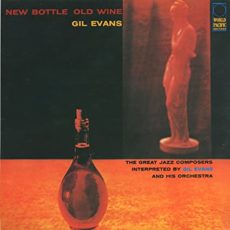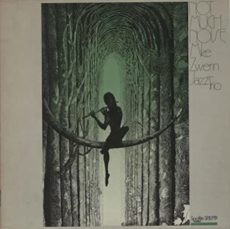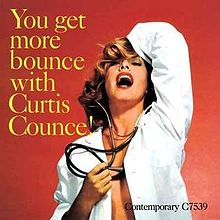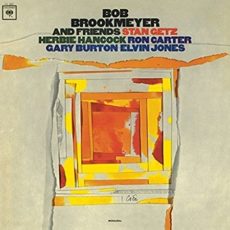
Daily Dose Of Jazz…
Bill Barber was born John William Barber on May 21, 1920 in Hornell, New York. He started playing tuba in high school and studied at the Juilliard School of Music. After graduating, he traveled west to Kansas City, Missouri, where he played with the Kansas City Philharmonic and various ballet and theatre orchestras.
Joining the United States Army in 1942, he played in Patton’s 7th army band for three years. After the war, he started playing jazz, joining Claude Thornhill’s big band where he became friends with trombonist Al Langstaff, pianist Gil Evans and saxophone player Gerry Mulligan in 1947. Barber was one of the first tuba players to play in a modern jazz style, playing solos and participating in intricate ensemble pieces.
Barber became a founding member of Miles Davis’s nonet in 1949 in what became known as the Birth of the Cool recording sessions. He then worked in the theatre pit orchestras of The King and I, Paradiso, and the City Center Ballet. He joined up with Davis and Gil Evans in the late 1950s to record the albums Sketches of Spain, Miles Ahead and Porgy and Bess. Barber also played tuba on John Coltrane’s album Africa/Brass released in 1961.
Completing a master’s degree from the Manhattan School of Music and became an elementary school music teacher at Copiague, New York. He continued to play where possible including with the Goldman Band. In 1992, he recorded and toured with a nonet led by Gerry Mulligan, reworking material from Birth of the Cool.
From 1998 to 2004 he was part of The Seatbelts, New York musicians who played the music of the Japanese anime Cowboy Bebop. Over the course of his career, he recorded with Art Blakey, Bob Brookmeyer, Kenny Burrell, John Coltrane, Miles Davis, Gil Evans, Urbie Green, Gigi Gryce, Slide Hampton, and Pete Rugolo. Tubist Bill Barber, who was also known as Billy Barber, passed away from heart failure on June 18, 2007 in Bronxville, New York.
More Posts: history,instrumental,jazz,music,tuba

Daily Dose Of Jazz…
Mike Zwerin was born in New York City on May 18, 1930, where he studied at the High School of Music and Art. He began leading bands in his teens, employing several up-and-coming musicians. He went on to attend the Univerity of Miami and after graduation, he went into his father’s business, the Capitol Steel Corporation.
At the age of 18, while on his summer holidays from the University of Miami, he was spotted by Miles Davis at Minton’s in Harlem, while sitting in with Art Blakey. He was immediately drafted into the rehearsal band for what would become immortalized as Birth of the Cool, while the regular trombonist Kai Winding was indisposed. Also present were Gerry Mulligan, Max Roach, and Lee Konitz. His contribution, in particular, his solo on the track Move, can be heard on The Complete Birth of the Cool. A few muddy recordings exist of radio broadcasts by the band during Zwerin’s time in it, which gave him a lifelong reputation as a jazz musician lucky enough to have been at the cutting edge of a new movement.
Abandoning his musical life for much of the 1950s and after a spell in France, he returned to New York in 1958 and played the trombone in several big bands. Among his other recordings are Getting Xperimental over U, and Mack the Knife, an album of Kurt Weill songs that he produced and arranged himself. He also appears on Archie Shepp’s 1968 album The Magic of Ju-Ju.
Before moving permanently to Europe in 1969, he was a jazz critic for the Village Voice and focusing on journalism, writing for Down Beat, Rolling Stone, and Penthouse before joining the Herald Tribune. Zwerin’s move to London, England in 1969 and then to Paris, France in 1972, would be his home for the rest of his life. Nevertheless, he kept his hand in as a trombonist throughout the 1980s, working with his fellow expatriate Hal Singer and with the guitarist Christian Escoudé. In 1988 he toured with the Charles Mingus Big Band, having played briefly with the Swiss bandleader George Gruntz and played with the French fusion band Telephone.
Zwerin’s lasting claim to fame, however, is, perhaps, not his trombone playing but his book La Tristesse de Saint Louis: Swing Under the Nazis (1985). He spent two years researching it, traveling across France, Austria, Poland and Germany to interview survivors and unearthing the story of how jazz was banned by the Nazis as degenerate music, and yet somehow survived as what Zwerin called a metaphor for freedom.
Cool and progressive jazz trombonist and bass trumpeter Mike Zwerin passed away on April 2, 2010 after a long illness in Paris at the age of 79.
More Posts: bandleader,critic,history,instrumental,jazz,music,trombone,trumpet

Requisites
You Get More Bounce with Curtis Counce! is a studio album by bassist Curtis Counce recorded on October 8 & 15, 1956, April 27, May 13 and September 3, 1957, at Contemporary Studios in Los Angeles, California and subsequently released on the Contemporary Records label. The music falls somewhere between hard bop and cool jazz and Counce contributed two original compositions to the recording, Complete and Counceltation. The producer for the sessions was Lester Koenig.
Track Listing | 44:39 All compositions by Curtis Counce except as indicated
- Complete ~ 5:51
- How Deep Is the Ocean? (Irving Berlin) ~ 6:35
- Too Close for Comfort (Jerry Bock, Larry Holofcener, George David Weiss) ~ 5:36
- Mean to Me (Fred E. Ahlert, Roy Turk) ~ 4:31
- Stranger in Paradise (Alexander Borodin, George Forrest, Robert Wright) ~ 7:03
- Counceltation ~ 6:01
- Big Foot (Charlie Parker) ~ 9:02
- Curtis Counce ~ bass
- Jack Sheldon ~ trumpet
- Harold Land ~ tenor saxophone
- Carl Perkins ~ piano
- Frank Butler ~ drums
You Get More Bounce With Curtis Counce | by Eddie Carter
Simply stated, this is a superb album by bassist Curtis Counce and his quintet. Counce’s group was one of the better and more resilient bands on the West Coast during the late fifties. As a cohesive unit, the quintet’s interaction throughout the album delivers handsomely on the seven selections that make up this enjoyable set. The album opener is Counce’s Complete which begins with an impressive discussion between the rhythm section ahead of the melody. How Deep Is The Ocean? Is the ageless 1932 standard by Irving Berlin is a perfect vehicle for an affectionate performance by Land who adapts the song as easily as if it was originally created for jazz with a breathtakingly beautiful tenor sax reading of the melody and lead solo, anchored by Sheldon’s imaginative lyricism in support. Too Close For Comfort, the 1956 popular song by Jerry Bock, Larry Holofcener and George Weiss began life on Broadway in the musical production of Mr. Wonderful that year and has been recorded by an A-list of musicians and vocalists too numerous to mention. The 1929 popular song, Mean To Me by Fred Ahlert and Roy Turk has long been praised by critics as a “head of the class” standard for jazz musicians and vocalists to improvise.
Side Two opens with a bop-flavored midtempo rendition of Stranger In Paradise, the popular song from the 1953 musical, Kismet, written by Alexander Borodin, George Forrest, and Robert Wright. Counceltation, the second original by Counce and the title of the 1972 reissue of this album, due in part to the “original cheesecake cover” which enough people found offensive enough for Contemporary Records to replace it with a photo of the artist and his bass in an outdoor setting. The quintet returns to hard-bop on the album’s closer, Big Foot by Charlie Parker which gives everyone a chance to speak their piece on a lively joyride.
If you already own this album you know what to do. If you’re adding it to your collection, place the record on the turntable, drop the stylus, or slide the cd in the drive, crack open your favorite beverage, sit back and settle in to enjoy seven of the best sounding jazz cuts by The Curtis Counce Group that are spontaneous, soulful swinging at its best!
Source: Jazztracks by Eddie Carter | Excerpt: 1/2019 | atlantaaudioclub.org
More Posts: bass,choice,classic,collectible,collector,history,instrumental,jazz,music

Daily Dose Of Jazz…
Ronald “Ronnie” Ball was born December 22, 1927 in Birmingham, England. He moved to London in 1948, and in the early Fifties worked both as a bandleader and under Ronnie Scott, Tony Kinsey, Victor Feldman and Harry Klein.
1952 saw a move to New York City where he studied with Lennie Tristano. In the 1950s and in the Sixties he worked extensively around the jazz scene with Chuck Wayne, Dizzy Gillespie, Lee Konitz, Kenny Clarke, Hank Mobley, Art Pepper, J.J. Johnson, Kai Winding, Warne Marsh, Buddy Rich, Gene Krupa, Roy Eldridge and Chris Connor among others.
By the 1960s he relatively disappeared from music. Pianist, composer and arranger Ronnie Ball passed away in October,1984.
More Posts: piano

Daily Dose Of Jazz…
Robert Edward Brookmeyer was born an only child on December 19, 1929 in Kansas City, Missouri and began playing professionally in his teens. Attending though not graduating from the Kansas City Conservatory of Music, he played piano in big bands led by Tex Beneke and Ray McKinley, but concentrated on valve trombone from when he moved to the Claude Thornhill orchestra in the early 1950s.
He was part of small groups led by Stan Getz, Jimmy Giuffre, and Gerry Mulligan in the 1950s and during the Fifties and Sixties he played New York City clubs, television house band, studio recordings, and arranged for Ray Charles and others. In the early 1960s Brookmeyer joined flugelhorn player Clark Terry in a band and they appeared together on BBC2’s Jazz 625.
A move to Los Angeles, California in 1968 saw Bob becoming a full-time studio musician, spending 10 years on the West Coast, and sinking into a serious alcohol problem. After overcoming this debilitation he returned to New York and became musical director for the Thad Jones/Mel Lewis Orchestra in 1979. Writing for and performed with jazz groups in Europe from the early 1980s, he went on to establish and run a music school in the Netherlands, taught at the New England Conservatory of Music in Boston, Massachusetts, as well as other institutions.
Eight time Grammy nominated trombonist, composer, arranger, bandleader and educator Bob Brookmeyer, who played n the mainstream, cool, post bop and West Coast jazz genres, passed away on December 15, 2011 in New London, New Hampshire.
More Posts: trombone





